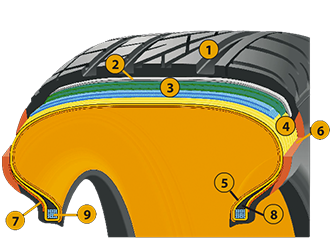Car tires are rarely seen as the most high-tech part of the vehicle. This could not be further from the truth. Tires are the only contact the vehicle has with the road, and are amongst the most technologically advanced components on your car. They are absolutely crucial to every motorist's safety.
In 1904, Continental became the first company anywhere in the world to develop car tires with a tread pattern. In 1908, it also becomes the first with removable rims for touring cars and in 1943, the first German company to make tubeless tires.
In 1960, Continental launched the first series production of belted tires.
The Contidrom test track was opened in 1967. Today, it is still one of the most advanced test tracks anywhere in the world, and far exceeds the latest requirements for tire testing.
Continental launched the first studless winter tire onto the market in 1970. More than 40 years later, Continental has continued to search for and develop new and innovative safety concepts.
The ContiEcoContact was launched and becomes the first truly eco-friendly car tire. For nearly 25 years, Continental has been at the forefront of developing environmentally-friendly automotive solutions.
In 2010, Continental introduces the first winter tires specifically designed for truck trailers. The tires contribute massively to safe motoring on wintry roads. The HSW 2 COACH winter tire has been developed for use in all wheel positions.
Continental has been at the cutting edge of advanced tire technology for over 140 years now. This is the engineering will and innovation that goes into every Continental tire, wherever it is sold, for whatever the automotive application.
Making sure you get there safely.

| 1 |
Treat Material: Synthetic and natural rubber |
| 2 |
Jointless cap plies Material: Nylon embedded in rubber |
| 3 |
Steel-cord for belt plies Material: High-strength steel cords |
| 4 |
Textile cord ply Material: Rayon or polyester (rubberised) |
| 5 |
Inner liner Material: Butyl rubber |
| 6 |
Side wall Material: Natural rubber |
| 7 |
Bead reinforcement Material: Nylon, aramid |
| 8 |
Bead apex Material: Synthetic rubber |
| 9 |
Bead core Material: Steel wire embedded in rubber |


